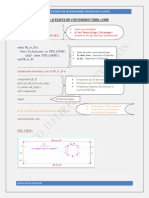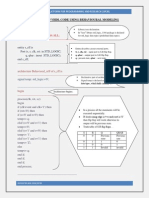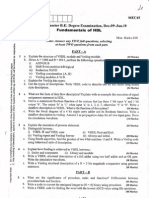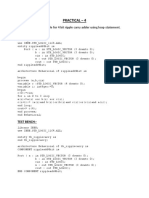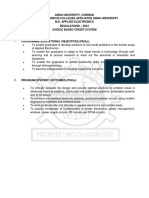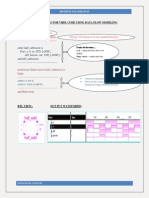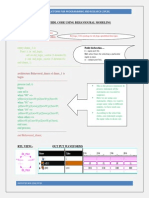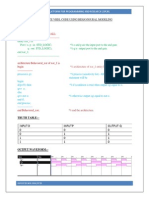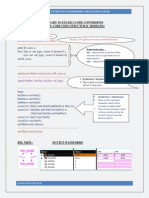T Flip-Flop VHDL Code Using Behavioural Modeling
Uploaded by
OP2RT Flip-Flop VHDL Code Using Behavioural Modeling
Uploaded by
OP2RONILNE PLATFORM FOR PROGRAMMING AND RESEARCH (OP2R) T FLIP-FLOP VHDL CODE USING BEHAVIOURAL MODELING
Library ieee declaration. In ieee library std_logic_1164 package is declared for std_logic data types (predefined data types).
library IEEE; use IEEE.STD_LOGIC_1164.ALL; -------------------------------------------------------
entity t_ff is Port ( T, clock, reset : in STD_LOGIC; Q,Q1 : out STD_LOGIC); end t_ff; ------------------------------------------------------architecture behavioral_tff of t_ff is -------------------------------------------------------Architecture begins. begin -------------------------------------------------------process (T, clock, reset) variable x: std_logic:=0; begin if (clock' event and clock='1' ) then if ( reset='1' ) then x<='0'; elsif ( T='0' ) then x<=x; elsif ( T='1') then x<=not x; end if; end if; Q<=x; Q1<=not x; end process; ----------------------------------------------------------end Behavioral_tff;
Entity describes circuit external ports. T , clock, reset: - input port to T flip flop. Q, Q1: - output port to T flip flop. Q:- present state, Q1: - next state.
In a process all the statements will be executed sequentially. In process, a variable (x) is declared to hold the output value. Its life is bounded till process end. If clock rising edge is +ve and reset is 0 then flip flop will work otherwise its output will be previous state. Truth table of T flip flops. T 0 1 Q Previous state toggle Q1 Previous sate toggle
INFOOP2R.WIX.COM/OP2R
ONILNE PLATFORM FOR PROGRAMMING AND RESEARCH (OP2R) RTL VIEWS:OUTPUT WAVEFORM:-
INFOOP2R.WIX.COM/OP2R
You might also like
- SR - To - T Flip Flop Conversion VHDL CodeNo ratings yetSR - To - T Flip Flop Conversion VHDL Code2 pages
- J-K - To - D Flip-Flop Conversion VHDL CodeNo ratings yetJ-K - To - D Flip-Flop Conversion VHDL Code2 pages
- 08.546 DSD With VHDL Lecture Notes - Module 1100% (1)08.546 DSD With VHDL Lecture Notes - Module 170 pages
- S-R Flip Flop Using Behavioural ModelingNo ratings yetS-R Flip Flop Using Behavioural Modeling2 pages
- SR - To - JK Flip Flop Conversion VHDL CodeNo ratings yetSR - To - JK Flip Flop Conversion VHDL Code2 pages
- D - To - J-K Flip Flop Conversion VHDL CodeNo ratings yetD - To - J-K Flip Flop Conversion VHDL Code2 pages
- Full Subtractor VHDL Code Using Data Flow Modeling100% (1)Full Subtractor VHDL Code Using Data Flow Modeling1 page
- VHDL Code For 1 Bit Comparator by Data Flow Modelling, Structural Modelling and Behavioural ModellingNo ratings yetVHDL Code For 1 Bit Comparator by Data Flow Modelling, Structural Modelling and Behavioural Modelling10 pages
- VHDL Code For 4-Bit Ring Counter and Johnson Counter100% (1)VHDL Code For 4-Bit Ring Counter and Johnson Counter8 pages
- Unit IV Synchronous Sequential Circuits NewNo ratings yetUnit IV Synchronous Sequential Circuits New28 pages
- State Diagram Traffic Light 4 Junction Verilog CodingNo ratings yetState Diagram Traffic Light 4 Junction Verilog Coding22 pages
- Ap9212 Advanced Digital System Design L T P c3 0 0 3100% (1)Ap9212 Advanced Digital System Design L T P c3 0 0 31 page
- Half Subtractor Half Subtractor - Gate Level ModellingNo ratings yetHalf Subtractor Half Subtractor - Gate Level Modelling10 pages
- Half Subtractor VHDL Code Using Structrucral Modeling0% (3)Half Subtractor VHDL Code Using Structrucral Modeling2 pages
- AIM: - Write A VHDL Code For 4 Bit Ripple Carry Adder Using Loop Statement. CodeNo ratings yetAIM: - Write A VHDL Code For 4 Bit Ripple Carry Adder Using Loop Statement. Code4 pages
- Full Adder VHDL Code Using Structural Modeling91% (11)Full Adder VHDL Code Using Structural Modeling2 pages
- Question Bank For CAD Algorithms For VLSI DesignNo ratings yetQuestion Bank For CAD Algorithms For VLSI Design4 pages
- Half Subtractor VHDL Code Using Behavioural ModelingNo ratings yetHalf Subtractor VHDL Code Using Behavioural Modeling1 page
- Radix-4 Modified Booth's Multiplier Using Verilog RTLNo ratings yetRadix-4 Modified Booth's Multiplier Using Verilog RTL10 pages
- Digital Switching and Logic Design: Prof. Ananda MNo ratings yetDigital Switching and Logic Design: Prof. Ananda M13 pages
- Linear Integrated Circuits - Lecture Notes, Study Material and Important Questions, AnswersNo ratings yetLinear Integrated Circuits - Lecture Notes, Study Material and Important Questions, Answers10 pages
- Ripple Carry Adder VHDL Code Using Structural Modelling0% (1)Ripple Carry Adder VHDL Code Using Structural Modelling1 page
- Reflection Coefficients For Lattice RealizationNo ratings yetReflection Coefficients For Lattice Realization8 pages
- Half Adder VHDL Code Using Behavioural Modeling100% (5)Half Adder VHDL Code Using Behavioural Modeling1 page
- 3.3.1-Problems On Stop and Wait Flow ControlNo ratings yet3.3.1-Problems On Stop and Wait Flow Control19 pages
- Half Adder VHDL Code Using Dataflow ModelingNo ratings yetHalf Adder VHDL Code Using Dataflow Modeling1 page
- Half Adder VHDL Code Using Structrucral Modeling100% (2)Half Adder VHDL Code Using Structrucral Modeling1 page
- Half Subtractor VHDL Code Using Dataflow ModelingNo ratings yetHalf Subtractor VHDL Code Using Dataflow Modeling1 page
- Decoder VHDL Code Using Behavioural Flow ModelingNo ratings yetDecoder VHDL Code Using Behavioural Flow Modeling1 page
- Binary To Gray Converter VHDL Code Using Structural Modeling67% (3)Binary To Gray Converter VHDL Code Using Structural Modeling1 page
- Full Subtractor VHDL Code Using Structural ModelingNo ratings yetFull Subtractor VHDL Code Using Structural Modeling2 pages
- Demux VHDL Code Using Behavioural ModelingNo ratings yetDemux VHDL Code Using Behavioural Modeling1 page
- Full Adder VHDL Code Using Data Flow ModelingNo ratings yetFull Adder VHDL Code Using Data Flow Modeling1 page
- 2's Complement VHDL Code Using Structrucral ModelingNo ratings yet2's Complement VHDL Code Using Structrucral Modeling2 pages
- 1's Complement VHDL Code Using Structrucral ModelingNo ratings yet1's Complement VHDL Code Using Structrucral Modeling1 page
- 2's Complement VHDL Code Using Data Flow Modeling67% (3)2's Complement VHDL Code Using Data Flow Modeling1 page
- Binary To Excess 3 VHDL Code Using Structural ModelingNo ratings yetBinary To Excess 3 VHDL Code Using Structural Modeling1 page
- 1's Complement VHDL Code Using Dataflow ModelingNo ratings yet1's Complement VHDL Code Using Dataflow Modeling1 page


